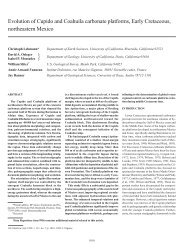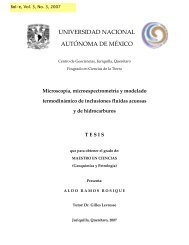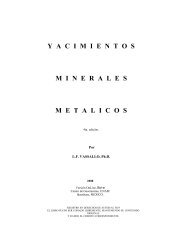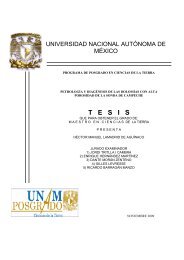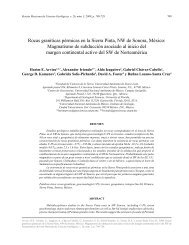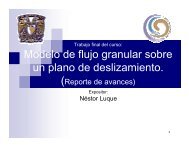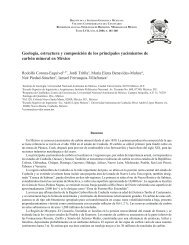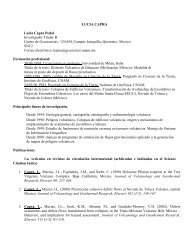Rocas de falla - Centro de Geociencias ::.. UNAM
Rocas de falla - Centro de Geociencias ::.. UNAM
Rocas de falla - Centro de Geociencias ::.. UNAM
Create successful ePaper yourself
Turn your PDF publications into a flip-book with our unique Google optimized e-Paper software.
<strong>Rocas</strong> <strong>de</strong> <strong>falla</strong>
<strong>Rocas</strong> <strong>de</strong> <strong>falla</strong> formadas en distintas<br />
profundida<strong>de</strong>s<br />
Km<br />
Incohesive gouge<br />
and breccia<br />
4<br />
Cohesive<br />
fabric<br />
Fault zone<br />
10<br />
Pseudotachylyte<br />
15<br />
250°-350°<br />
Ductile shear zone<br />
Cohesive,<br />
foliated rocks<br />
mylonites<br />
QP REGIME FR REGIME
Oaxaca<br />
Shear Zone<br />
Fallas normales<br />
Cenozoicas<br />
0 20 km<br />
Teotitlán<br />
18º N<br />
N<br />
N<br />
Cuicatlán<br />
N<br />
Oaxaca Fault<br />
Ixtlan<br />
Donají Fault<br />
17º N<br />
Coax<br />
30 km
Falla San Luis Tepehuanes
Salbanda no cohesiva y zona <strong>de</strong><br />
brechas<br />
Km<br />
4<br />
10<br />
15<br />
250°-350°
Transición<br />
frágil-dúctil<br />
Km<br />
4<br />
10<br />
15<br />
250°-350°
Km<br />
4<br />
10<br />
15<br />
250°-350°<br />
Mylonite<br />
0 5 cm 0 0.1 cm
Km<br />
4<br />
10<br />
15<br />
250°-350°<br />
S-C mylonites
Contacto entre<br />
<strong>falla</strong>s formadas a<br />
distinta profundidad
Tipo <strong>de</strong> <strong>falla</strong>: Normal<br />
Orientación <strong>de</strong> esfuerzos: 1 vertical<br />
Tipo <strong>de</strong> <strong>de</strong>formación: extensional<br />
<br />
3
Tipo: Falla inversa<br />
orientación <strong>de</strong> esfuerzos: 3 vertical<br />
Tipo <strong>de</strong> <strong>de</strong>formación: acortamiento<br />
3
Tipo: Falla lateral<br />
orientación <strong>de</strong> esfuerzos: 2 vertical<br />
<br />
3
Reconstrucción <strong>de</strong> México durante el Jurásico<br />
D2, D3<br />
180 MA<br />
160 MA<br />
(según Ross y Scotese, 1988)



